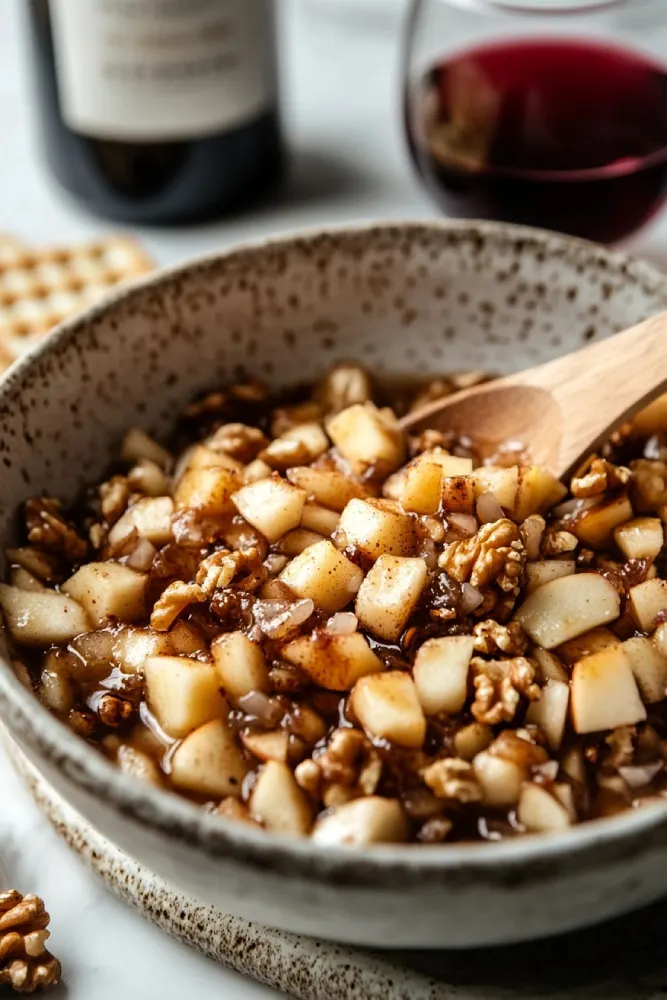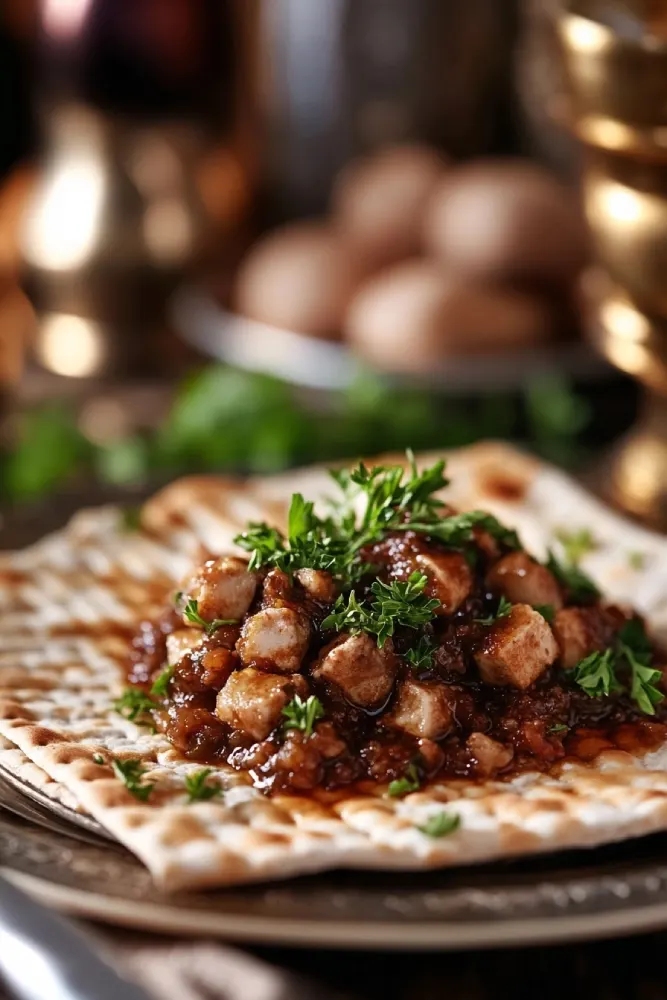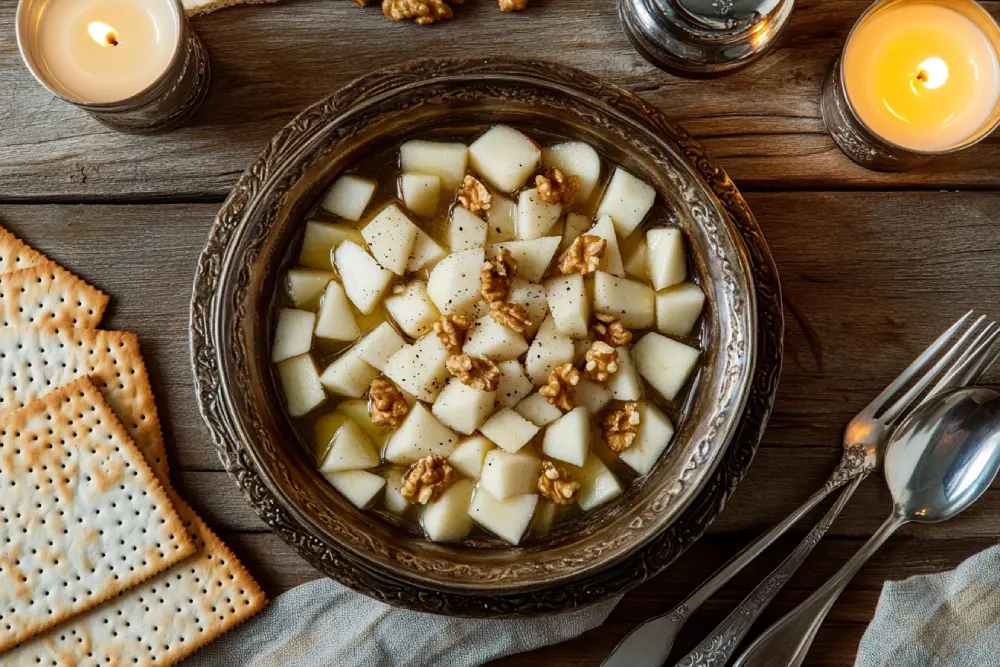Charoset is a signature dish on the Passover table, rich in tradition and flavor. Whether you’re preparing for your Seder or just curious about Jewish cuisine, this charoset recipe is your go-to guide. Made with apples, nuts, wine, and spices, charoset connects generations through taste and symbolism. In this article, we dive into everything you need to know about the perfect charoset recipe—from Ashkenazi to Sephardic styles, ingredient tips, and storage advice. This sweet mixture belongs at every Seder and deserves a spot in your kitchen.
What is Charoset? (Traditional Passover Charoset Recipe Introduction)
History and symbolism of charoset in Passover
Charoset holds deep meaning during Passover. Every charoset recipe tells a story of slavery and freedom. Like other symbolic holiday dishes such as the Ugadi Pachadi recipe, charoset connects history, heritage, and faith into a single bite.
No Passover Seder is complete without charoset. It’s not just a side dish. It’s a spiritual symbol wrapped in flavor. The ingredients in any charoset recipe are chosen to reflect texture, sweetness, and symbolism. The mix of fruits, nuts, and wine mirrors both suffering and redemption.
Cultural variations: Sephardic vs Ashkenazi charoset
Charoset recipes vary by region. Ashkenazi Jews often prepare charoset with chopped apples, walnuts, cinnamon, and sweet red wine. It’s chunky, fresh, and lightly spiced. This version is most common in Eastern Europe and the U.S.
Sephardic charoset is a different experience. It uses dates, raisins, figs, and almonds. Some versions add ginger or cardamom for extra warmth. This charoset recipe results in a darker, paste-like texture. Both versions hold deep symbolic value and are often passed down through generations.
Key Ingredients in a Classic Charoset Recipe
Apples, nuts, and wine: Core charoset ingredients
A traditional charoset recipe begins with three essentials: apples, walnuts, and wine. Apples bring a crisp sweetness. Walnuts offer crunch. Wine brings depth and unites the flavors. These are the base of any classic charoset recipe.
The balance between sweet and earthy gives charoset its character. The ingredients represent more than taste. They echo ancient stories and customs passed on through Jewish history.
Spices and sweeteners: Cinnamon, honey, and beyond
Cinnamon is the spice of choice in most charoset recipes. It adds warmth and complements the apples and wine. Many recipes also include honey, though it’s optional. Honey adds smoothness and sweetness. Some families use maple syrup or even sugar, but natural sweetness from fruit is always preferred.
To elevate the flavor of your charoset recipe, consider adding a dash of nutmeg or allspice. A few families even mix in orange zest or dried cranberries for a modern twist.

Best Apples for Charoset (And Whether to Peel Them)
Do you have to peel apples for charoset?
Peeling is traditional but optional. Peeled apples offer a smoother texture and absorb wine more evenly. Leaving the peel adds color and fiber but may create a more rustic consistency.
Most traditional recipes recommend peeling, especially if serving to guests who expect a smoother dish.
Tart vs sweet: What kind of apples are best?
Balance is key. Tart apples like Granny Smith mix well with sweeter varieties like Fuji or Gala. Combining both adds depth of flavor and natural complexity.
Best apple combinations for charoset:
| Tart Apples | Sweet Apples |
|---|---|
| Granny Smith | Fuji |
| Braeburn | Honeycrisp |
| Pink Lady | Gala |
Which Wine is Best for Charoset?
What kind of wine for charoset: Dry vs sweet debate
Sweet red kosher wine, such as Manischewitz, is the classic choice. Its syrupy texture and sugary notes complement the apples and nuts perfectly. If you prefer a lighter taste, use dry red wine and add a teaspoon of honey or sugar.
Non-alcoholic substitutions for family-friendly versions
Grape juice is a common and acceptable substitute, especially for children or those avoiding alcohol. Choose 100% concord grape juice for that rich flavor. Pomegranate juice is also a flavorful, tart alternative.
Step-by-Step Ashkenazi Charoset Recipe
Ingredients list with measurements
Here’s a simple version of Ashkenazi charoset, ideal for about 6 servings:
| Ingredient | Amount |
|---|---|
| Apples (peeled & diced) | 3 medium |
| Chopped walnuts | 1 cup |
| Sweet red wine | 1/2 cup |
| Honey (optional) | 1–2 tsp |
| Ground cinnamon | 1 tsp |
How to mix and store for best flavor
- Dice apples very finely or grate them for a smoother texture.
- Mix with chopped walnuts.
- Add wine slowly until mixture is moist but not soggy.
- Stir in cinnamon and optional honey.
- Cover and refrigerate for at least 1 hour to let flavors meld.
Charoset can be made a day ahead. The flavors deepen over time, making it even more delicious the next day.

Sephardic Charoset Recipe Variation
Dates, figs, and raisins: Sephardic ingredients explained
Sephardic charoset replaces apples with dates, raisins, and sometimes figs or apricots. These dried fruits are soaked and blended into a rich paste, often sweetened naturally. This version may include almonds instead of walnuts.
Typical ingredients:
- Dates (pitted and soaked)
- Raisins
- Figs or dried apricots
- Almonds
- Red wine or grape juice
- Spices like cinnamon, ginger, or allspice
Texture and taste differences from Ashkenazi style
This version is darker, thicker, and more paste-like. The flavors are intensely sweet, with earthy spice undertones. It’s more spreadable and pairs beautifully with matzo or as a dip. Sephardic charoset is often shaped into small balls or logs for serving.
Tips for Serving and Pairing Charoset
How to serve charoset on the Seder plate
Charoset is placed on the Seder plate along with maror (bitter herbs) and other symbolic items. During the meal, it’s eaten with matzo and maror to symbolize the sweetness and bitterness of slavery and freedom.
The Sephardic charoset recipe often feels like dessert. If you enjoy unique dessert dishes, the Heaven on Earth Cake is another example of rich, layered flavors that honor tradition with a sweet twist.

Creative uses: Spread, topping, or sweet dip
Outside the Seder, charoset can be:
- Spread on toast or matzo
- Used as a topping for oatmeal or yogurt
- Rolled into date-nut energy bites
- Added to cheese boards for a sweet contrast
Its versatility makes it a fun and nutritious addition to many meals.
How to Store Charoset and Make Ahead Tips
Refrigeration and freezing guide
Charoset lasts well in the refrigerator for 4–5 days in an airtight container. The wine acts as a natural preservative, and the flavors deepen over time.
To freeze charoset:
- Use freezer-safe containers
- Label with date
- Thaw in fridge before serving
Charoset also pairs beautifully with beverages. For a warm drink option during Passover, consider a soothing Matcha Latte to balance out the sweetness.
How long does charoset last and best containers to use
Use glass containers with tight lids to preserve taste and aroma. Avoid plastic that may absorb smells.
Ashkenazi charoset should be eaten within 3–4 days for best texture. Sephardic paste can last up to 7 days when stored properly.
FAQ Section
What is charoset made of?
Charoset typically includes apples, nuts (like walnuts or almonds), sweet red wine, cinnamon, and sometimes honey or dried fruits depending on regional variations.
Do you have to peel apples for charoset?
Peeling apples is traditional for smoother texture, but it’s optional. Leaving the peel adds color and fiber.
What kind of wine for charoset?
Sweet kosher red wine like Manischewitz is classic. Grape juice is a good non-alcoholic alternative.
Do you put honey in charoset?
Honey is optional. It adds extra sweetness and richness but isn’t required if using sweet wine or fruits.
Can charoset be made ahead of time?
Yes. It can be made 1–2 days ahead and stored in the refrigerator. The flavor improves with time.
What nuts are best for charoset?
Walnuts are traditional for Ashkenazi versions, while almonds are common in Sephardic recipes.
Conclusion
Charoset is more than a ceremonial food — it’s a bridge between generations, a blend of memory and taste. Whether you prefer the crisp, apple-based Ashkenazi style or the date-rich Sephardic version, charoset invites you to bring tradition to your table in a way that’s both meaningful and delicious. With just a few ingredients and simple steps, this sweet staple can become part of your family’s Passover celebration.



